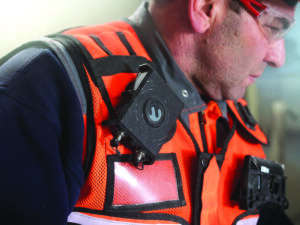
Conextivity Group, developer of the Wearin’ lone worker protection system shown here, said it provides an end-to-end connectivity solution that’s reliable, modular and scalable, capable of adapting to the specific requirements of each client.
A Switzerland-based technology group recently pointed to studies estimating that in Europe alone, there may be as many as 10 million lone workers, many of whom function in high-risk environments and could benefit from connected wearable IoT solutions designed to enhance safety and productivity. It’s a universal problem that has been exacerbated since the global COVID-19 pandemic changed the nature of work — and the workforce — in many industrial sectors, resulting in smaller employee rosters and more reliance on lone workers. A 2022 study of 250 lone worker professionals in North America indicated that almost one in five reported having an accident and encountering difficulty getting help, while just under half reported feeling generally unsafe about their work conditions.
As a potential solution, Conextivity Group highlighted its Wearin’ brand’s lone worker protection equipment, designed to reliably detect falls and alert a control center in the event of an accident. Wearin’ and Fischer Connectors comprise the group’s two core businesses focused on connectivity solutions that manage power and data flows seamlessly from sensors and devices.
Based on IoT technology and powered by AI, the Wearin’ product incorporates two platforms, one physical and the other digital, communicating with each other in real time. A device attached to the worker’s vest, called the Wearin’ Brain, embeds three safety alert and detection systems: one to alert the control center via an SOS button that can be activated manually in the event of an accident; an inertial sensor that can automatically detect a fall in case the alert cannot be raised manually; and GPS to pinpoint the precise location of the worker.
Data and alerts are sent and collected via the cloud to the Wearin’ dashboard integrated into a central monitoring system, allowing recipients to take appropriate emergency and rescue measures according to the alerts they have received.
Alvaro Goncalves, technical director at Wearin’, explained that in addition to the SOS button, the fall detection sensor and the GPS system, a 10-hour battery allows the Brain to last an entire shift without additional charging, and an LTE module provides for secure data transmission to the alarm center.
The fall detection sensor designed by Wearin’ minimizes the risk of false positives experienced with other, less advanced competing products, according to the company. Aurélie Balsa, embedded software manager at Wearin’, noted that: “The critical problem faced by this type of system is the frequency of false positives and the impact they have on the worker. The detection provided by other products is sometimes so unreliable that users, annoyed by repeated false alarms, end up disconnecting the system altogether. Wearin’s solution comprises hardware, firmware and embedded algorithms. Based on data from our accelerometer and gyroscope, our algorithms reduce false positives to less than 1%.”
Jonathan Brossard, CEO of Conextivity Group, commented: “The trend we’re seeing in this sector is a strong and genuine concern on the part of companies for the health and safety of their employees. These companies no longer want to limit themselves to ticking the boxes on safety checklists provided by regulatory authorities. They demand real solutions to the real-life issues specific to their operations.”

